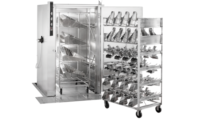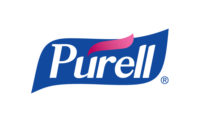Maintaining hygiene is a never-ending battle in food-processing facilities. Plants that use Good Manufacturing Practices (GMPs) usually follow a Hazard Analysis and Critical Control Points (HACCP) management system, including daily or weekly procedures that ensure production and working conditions remain sanitary and free of contamination. However, some cleaning tasks are not required daily or even monthly.
Keeping areas healthy and free from dirt and debris inside food product zones can be challenging to both employees working the conveyor lines and sanitation managers. Potential problems often occur in unseen places and can be so infrequent that a sanitation manager may be stumped as how to address a problem when it arises.
Particulates may be falling into products inside a dirty oven. The grease-laden exhaust ducts are catching on fire. (The image above shows an exhaust duct before [left] and after [right] cleaning.) The heating, ventilation and air conditioning (HVAC) system is spitting out flour, sugar and powdered milk that have built up over the years. Mold is growing in silos where corn flour is caked on from lack of cleaning for months or years. Oil storage tanks have sludge at the bottom that you know no inspector wants to see. Veteran sanitation managers are familiar with these conditions and are prepared for them—through in-house cleaning or outsourcing—when the need for maintenance arises.
Also, with the recently passed Food Safety Modernization Act (FSMA), sanitation managers’ focus has shifted to a greater alertness to hygiene issues to prevent food safety problems, rather than reacting to food contaminant issues after they occur.
Let’s look at some of the basic components of a food-processing facility, the sanitation challenges they offer manufacturers and how they can be handled effectively.
Ovens
Ovens are commonly the workhorses of a food-processing plant, faithfully putting in long hours and delivering finished products day and night. But the constant progression of products through an oven takes its toll on this equipment. Crumbs fall from baked products. Lubricants from conveyor belts can build up and fall to the floor. Fumes from the baking process leave residue on walls and moving parts. Such debris can become a fire hazard or fall into and contaminate products. When this happens, ovens need to be cleaned.
The first step in oven cleaning is turning off the oven, so it can cool enough to permit workers inside. This cooling period may take eight to 24 hours or more. Scheduling a cleaning must be calculated into your downtime. If the oven is longer than 100 feet, fans should be placed at the ends to move air through the oven, so workers can breathe freely.
A second step is removing interior parts, such as shelves or compartments, if possible and if they prevent workers from fully accessing and cleaning the oven. Manuals from the oven manufacturer can be helpful.
OSHA-confined space regulations may apply as well as other safety concerns. Proper personnel protective equipment plus the correct tools—scrapers, nonflammable solvents, vacuums and occasionally even mechanical grinders—permit workers to get in and out of the oven safely and get the job done.
Tanks
Tank cleaning is a bit more specialized. But when you have caked-on layers of goop contaminating your products or reducing your storage capacity, cleaning a tank is usually much cheaper than replacing it.
Again, confined space regulations may apply, and there is also a strong possibility that workers may need respirators, depending on the level of fumes and available oxygen supply. Entrance into and egress from the tank—as well as removal of contaminants—must be managed safely.
Cleaning could require pumping at first and then scraping of final residue. Chisels or even jackhammers can come into play if the residue is hard and the tank is worth saving. Power washing or steam cleaning can lift oxygen right out of the tank, so workers may need supplemental breathing apparatus.
Ceilings
Plant managers are often caught by surprise when an inspector tours the plant, looks up, shakes his head and writes: “Rafters, beams, pipes and/or exposed ductwork covered in dirt and debris. Fire hazard, breathing hazard, unsafe working conditions.” Or maybe the sanitation manager has already reported complaints of debris falling into the production lines.
Ceiling cleaning is difficult because it takes mechanical lifts and man hours. Most lifts can’t be operated alone and must be repositioned frequently. Safety regulations also apply to lifts. Shutdown time may be significant if you can’t work around the production process. If you’re lucky, debris brushes or vacuums up easily, although part of it could be solid residue requiring more aggressive cleaning methods.
Silos
Of all the components discussed, silos are the most likely to need cleaning frequently or on a regular basis. Pests can become a problem. The confused flour beetle, a frequent resident of silos, grows from an egg to an adult in 28 days, so a thorough cleaning may be the most effective way to prevent infestations.
Mold, another major concern, is commonly visible as shades of green and black in the flour, particularly on inside silo walls. As much as an inch-thick (or more) layer of greenish flour can cling to walls. Mold growth is facilitated by the presence of moisture, which can occur when warm flour is pumped into a silo and then cools down. Dehumidifiers can help guard against this problem.
Cleaning silos usually requires manual entry. Interior walls should be brushed and scraped. Again, confined space regulations commonly come into play, and the air should be tested for oxygen levels, explosive particulates and flammables. Steps should be in place to prevent workers from falling into or accidentally “drowning” in flour. Lockout/tag-out rules should be followed during all cleaning tasks, but they are even more significant with silos, where a switched-on motor can pull a worker into sweeping blades at the bottom of the silo.
HVAC and other ducts
HVAC and other duct systems commonly get contaminated in food-processing plants. Food particles and cooking vapors circulate or are exhausted from the facility, and over time, naturally stick to the inside of ducts, fans and air conditioning units. This can impair ventilation performance, cause particles to blow into the facility or create a fire hazard. Routine AC filter replacement is an easy step in controlling the clean air supply entering the food-product zone.
Cleaning duct systems is rarely done in-house due to the technical expertise required. The National Air Duct Cleaners Association (NADCA) governs HVAC cleaning, and its website, www.nadca.com, is one of the simplest ways to find a quality contractor in your area.
Cooking exhaust systems, where grease builds up in ductwork exhausting stoves or ovens, may be cleaned by the same NADCA company, or you may need to find someone who specializes in that trade. The International Kitchen Exhaust Cleaners Association (IKECA) sets the standards for this field and lists member companies at www.ikeca.org.
Staying on top of cleaning in a food-processing plant means not only tracking daily and weekly chores, but also thinking long-term. Some areas need inspecting or cleaning every year, or every five or 10 years, to keep a facility from becoming a crusty one. Veteran sanitation managers who have had their share of unpleasant surprises know that odd cleaning jobs are all part of typical plant maintenance. SF&WB
Dan Stradford is CEO of Action Duct Cleaning, Altadena, CA. He is on the board of directors of the National Air Duct Cleaners Association, chairman of its Certification Committee, and editor and chairman of its technical papers. He is also an IKECA certified exhaust cleaning specialist and has authored three books and more than 250 articles and papers.
Robert Verdugo is a senior account engineer for the western U.S. for Action Duct Cleaning and a member of AIB International and BEMA (Bakery Equipment Manufacturers and Allieds).




